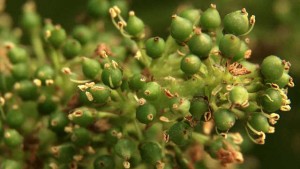Every day, San Francisco’s compostables – all 600 tons of them – are hauled away from the city. I found myself asking, “Where does it all go?”
While looking for the answers, I found agronomist Bob Shaffer. Shaffer started out as a farmer, but soon realized that he was more interested in the soil than in what grew out of it. That led to a career in making and applying compost. He now works with Recology, the company that composts San Francisco's green waste, at their composting facility in Vacaville and with farmers who want to improve their crops.
One of Shaffer’s clients is Old Hill Ranch in Glen Ellen. As the name suggests, the vineyard is one of the earliest in Sonoma County and has many 100-year-old vines.
When Old Hill was first established, it was planted in the traditional way – a lot of different grape varietals were planted, producing a blended wine. The vineyard has a colorful map that identifies the patchwork of varietals on the property.
The vines are dry farmed, with no irrigation system running between the vine rows. This makes adding compost really important, as it helps with water retention in the soil. Old Hill’s owner, Will Bucklin, is also experimenting with compost tea, in which a small amount of compost is “brewed” into a dark tea to develop beneficial microbes. The tea can be added to a water supply or sprayed onto the leaves directly. It’s another way of making nutrients and protective microbes available to the plant.

When QUEST visited Old Hill Ranch, it was a hot, sunny June day. There had just been a full moon and the blooms on the vines had set into tiny green grapes.